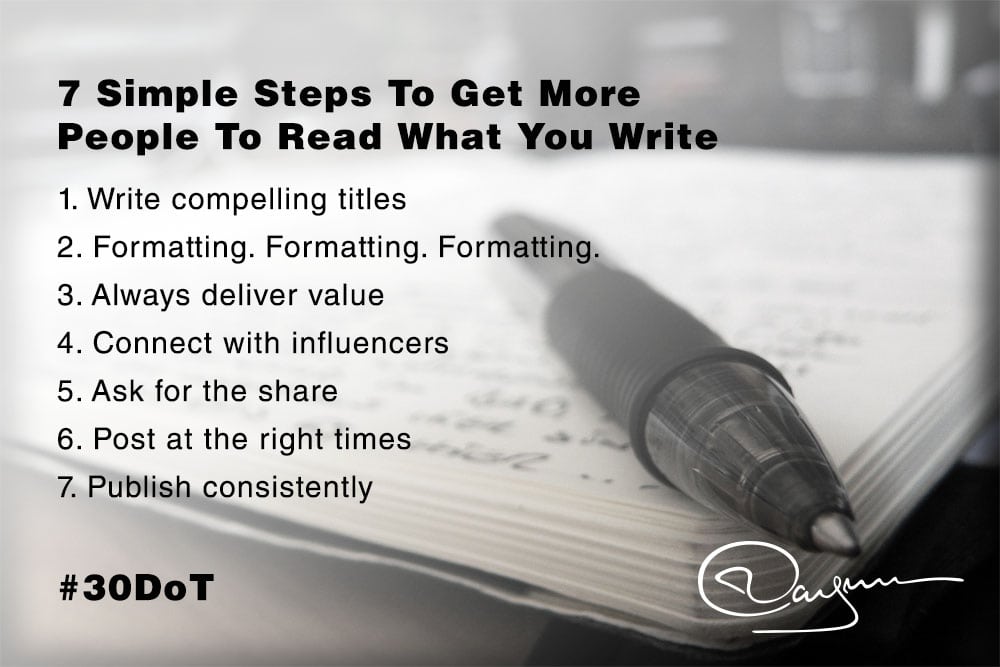A comprehensive guide to creating, sharing and nurturing viral content online.
Listen and read along as we teach you how to build a strong organic online presence.
People ask me all the time…
“How do you get so many people to your website?”
They want to know what I have done to increase my online exposure and how I get such got such a large audience in such a short amount of time.
Most of what I have done has been trial and error and even now we are constantly experimenting with different formats of content in an attempt to perfect our art, but there are a few things we have learned along the way that can definitely help you reach your online goals.
In this podcast…
We talk about the process of creating, sharing and nurturing viral content in some serious detail.
I invited Sean Smith to join me in this episode of RayDO (pronounced Ra-di-o) Uncensored. Sean is a prolific writer and you can find his work on a number of national publications including the Hufington Post, 99U, Moz and Medium.
I suggest you take notes along the way, as we dive deep into the process of creating, sharing and nurturing viral content. You should also listen to the entire podcast for a deeper understanding of our entire content conversation, especially since the notes below are just an overview of everything we talk about in the podcast.
As always, if you find value in the podcast, please be sure share it with a friend, subscribe and grab us on Stitcher. That way you can get all of our newest content first.
2:50 – Skip the audio intro
I always like to let you skip the intro so if you don’t want to hear the lead-in to the podcast just skip to about the three minute mark. Just remember, a baby squirrel will get run over by a car every time someone decides to do this.
In all seriousness, the beginning of these podcasts is where I briefly explain what the show is about and I also give occasional updates on what we are trying to build here at Raymmar.com. If you are interested in getting involved or want to know more about what we are doing then I suggest you listen all the way from the beginning.
4:00 – A quick intro to Medium
I have enjoyed some recent success on Medium (especially when my article reached #1 on their top 100 list) but I think they are changing some of the things that made them great. I am working on on article about why I think they might have messed up big time but I have also had some great success by sharing some of my posts on Medium.
I am not sure whether the changes they have made recently will affect their long term viability as a social sharing platform but I think you should know about it as a content creator because after all, finding new places to showcase your work is a big part of increasing your audience and building a viral presence online.
6:15 – Starting a blog
The race to stand out online is on in full force and most people are doing it all wrong. At this point in the podcast we start diving into the theory behind creating, sharing and nurturing the content in an attempt to create a continual viral presence online.
These strategies, although helpful when creating any content online, are not intended to help you get one specific article to go viral. The internet is a finicky place and you should worry less about creating individual pieces of viral content and instead focus your efforts on always putting your best work out there for the world to see.
Once you start driving enough traffic (assuming the site is interesting) people will start spilling over into the other sections of the website. What we are hoping to teach you on Raymmar.com is how to build a consistently strong arsenal of quality content and how to elevate your entire blog so that everything you do has a chance at going viral.
8:05 – It starts with a title?
For me it all starts with the title. I get an idea and then it evolves in my head as a theory but I am never fully inspired until the title hits me. Sean and I both agree on the importance of the headline as well as why it is so important to think about getting the readers attention early on. On the internet, many people do judge a book by its cover so be sure that your blog titles are as thought out as the content inside of them or in the end you re really just wasting your time.
It would be like throwing a huge party and then forgetting to send out the invites. Not the proper way to plan a party right? So why would you take the same approach to creating your online content?
9:30 – The evolution of an article
Most great content is not a one and done proposition. In this part of the podcast we talk about letting the content sit on the shelf and why you should let your stories and simmer. I think it is important to throw down all of your thoughts and then sleep on your idea for a few nights. Then you can come back and clean up the content to make sure you are always delivering your “A” material. I do not know many people who do everything perfect the first time around so if you really want your content to go viral then you really do need to take your time and make an art out of writing your articles.
11:30 – The structure and flow of the article
Sometimes you should just spit out all of your thoughts and then look at them on the screen and work on the structure and flow of the article. Then you can start moving pieces around and assembling the article in the way that makes the most sense. The structure of your article is important and you need to hook the reader early, especially online.
Blogging Tip:
You should be telling two stories through the course of the article and also make sure you are formatting it properly for online distribution.
Story one: Should be told in the headlines and subheadings. Consider this the top level story. A fly by of your high level ideas if you will. People are really impatient online so you need to make your article easily skimable while also trying to suck the reader in and get them to commit to reading the entire story.
Story two: Should be the article itself. This is the long form version of your story. This is where you can dive in and let your work shine. The other benefit to formatting your content like this (besides the value that long form content brings you in the sense of SEO) is that it makes long form content digestible. You can deliver more information in one place and not overwhelm the reader with a page that looks like it was copied and pasted from an encyclopedia.
15:05 – Delivering value to the reader
In order for your story to have a chance at going viral, there has to be a strong story line. At the end of the day, if your story sucks then no one is going to listen, read, watch, etc. You should make an attempt to educate and entertain your reader while telling that story. Think about the stuff that engages you online and then try to mimic and copy that approach but be sure to make it your own along the way.
You can use metaphors and other creative writing practices to give the reader some creative liberties while reading your work. This allows the reader to make your story their own and it allows them to create the environment in which the story takes place inside of their own head. You allow them to paint for themselves the vision that you are trying to share and then you put yourself in the perfect place to entice the reader to actually share your story.
17:06 – Leave the story up to the reader
The point that we are trying to make here is that getting something to go viral online becomes more about getting the reader to attach their emotions to the blog than just writing something interesting. Most businesses, entrepreneurs, etc. just want to pitch their products on their blog, but they forget about connecting with their audience in an emotional way. They forget to give something to the reader in the form of digestible value before asking for the sale.
Business blogs would be well served to understand the concept of connecting with their readers and should strive to turn their website into a place where their customers come to not only hang out but learn from you. Think of it as if you were building an online lobby for creative thought.
19:33 – Reading is the ultimate virtual reality
People can immerse themselves in your words. When they watch video they see the exact vision of what the person who created the art wanted them to see. But, when you are reading someones words or listening to their voice, the reader gets to become the artist. This leaves you with a beautiful opportunity as the author, to connect on multiple levels with your audience. It allows you to reach directly into the heads of your readers and paint with your words.
You also have to remember that it takes time to build an audience and a following online. You have to be willing to invest the time and hone your skills as not only a writer but a self promoter of the things you write. No one is going to read your early articles so don’t feel bad when you publish something and no one reads it. It happens to all of us when we first start out. You should use this early part of your online development process to test your writing style and keep experimenting with different techniques in order to find out what is going to work best for you.
23:25 – Building Credibility online
You can expect to spend as much time online building credibility in what you do as you do creating and distributing your content. In order to have the best chance to stand out online you need to find people in your area of expertise and start sharing content, connecting and engaging with them on their websites, blogs and social platforms. You need to connect with your readers, not only through your writing, but inside of your interactions as well. Building real relationships with your readers is important to maintaining a viral presence online and you should make it a top priority to respond to all of the comments made on your website as well as the social media sites that you are active on.
24:50 – Become an expert
You have to know what you are talking about before anyone is going to listen to you online. It is easy for anyone to start a website but that does not mean that everyone with a website is an expert. You should make it a point to become the best at whatever it is you are trying to explain to your audience. You have to prove to them that you know what you are talking about by being able to do what you are telling them to do for yourself.
If you doubt yourself or are making things up as you go in an attempt to fill up space, then your reader will not only know that you are faking it, but you will also destroy any small amount of credibility that you might have built up until this point. You must believe in yourself but that does not mean you need to be a tyrant when talking to your audience either. You need to know that what you are talking about is right and then find creative ways to relay that to your reader.
26:15 – Having actual authority vs. thinking you have it
Finding credibility online and building an overall viral presence on your website becomes a process of getting involved in the existing conversations online. This is a piece that many people forget about when trying to build their own blog from the ground up. Whenever you want to get other people involved in your conversations, then you should look for places where people are already talking about the things you are trying to talk about and find a way to get involved in their conversation. Do not be so naive that you think people are going to rush to your website when to talk about what you want when they are already in the middle of that discussion somewhere else. Instead, you should learn how to hack those conversations and become someone that they look to for advice on the issue. Then you can start funneling that conversation to your website and separate yourself as a thought leader in that category.
34:30 – Getting involved
If you are a regular listener then please join the conversation. We have a lot of people who come to the site more than 5 times a month and I would really like to get to know those people better. I want to know why you come to the site so regularly and what we can do to make that experience better for you. Please take a moment to reach out and leave me some feedback about your experience on the site and with this podcast, etc.
We are really trying to make this about the consumer experience and we want to build it into something beautiful for our readers and listeners.
37:05 – Remaining a student
Make sure that you are always learning. You should always think that other people are smart too and that other people can teach you something you mifht not already know. You should become a sponge and then regurgitate that info to your audience in a way that they can relate to or understand. The best teachers are always learning and the beauty of the internet is that it can easily become a medium by whitch information can be passed from one person to another and that is helping all of us learn at a really fast pace. More so than ever before.
Podcast correction – In the podcast I mention that we have shown up more than 100,000 times in Google search results but that number is actually closer to 1.3 million. Turns out I had some filters applied to the webmaster tools and that was restricting the results. Talk about a great mistake!
38:25 – A few final tips
Here is a link to the Gibbon.co learning platform that Sean was talking about at the end of the podcast.
As we wrap up the podcast, here are a few final thoughts from both Sean and I that will help you take some steps towards building a viral presence online.
Get in the habit of reading your writing out loud.
Seriously, this has been one of the best things I have done for my writing. It allows me to write as if I was actually speaking to someone which is important because when someone reads your work, the concepts could be entirely new to them. You cannot assume they know the things you know, or that they are thinking like you are thinking. It is up to you as the author to make sure that the flow of your work makes sense and reading your work out loud is one of the best ways to do just that.
Leave internal cliff-hangers.
When you tell your story, leave something for the reader to discover later in the writing. This will ensure that they remain engaged throughout the entire post. It can be difficult to learn at first but as your writing style matures you will get better at teasing out the hooks of the articles early on in the content and use them to drag the reader throughout your work in the exact manner which you intended. When you learn to do this then you can really have a chance at building something special online because it really does become about more than just reading a blog article at that point.
Get creative with the article structure.
Start from the end and then bounce around. Or in the middle then to the beginning. Don’t just think that your story has to go in chronological order. A little confusion for the reader is a good thing. Again, this is like leaving little hooks throughout the article. Things that draw the reader in and keep them around until the end.

 Content, content, content…
Content, content, content…









